通用启动器是指常用的jdk命令:java。为启动一个java应用程序,java将准备一个运行时环境,加载指定的类并调用它的main方法。
启动流程
main--->JLI_Launch()--->JVMInit()--->ContinueInNewThread()
--->JavaMain()--->InitializeJVM()
--->LoadClass()--->JNI_CallStaticVoidMethod()
--->JNI_DetachCurrentThread()-->LEAVE()
打开程序入口,可以看到最后调用了JLI_Launch()函数
JLI_Launch函数最后一步要执行的JVMInit
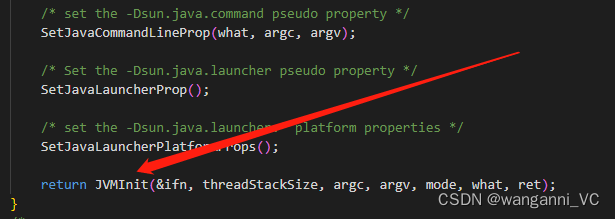
JVMInit函数中开始通过ContinueInNewThread创建新的Java进程

在ContinueInNewThread下有个函数ContinueInNewThread0,执行了当前的主方法JavaMain
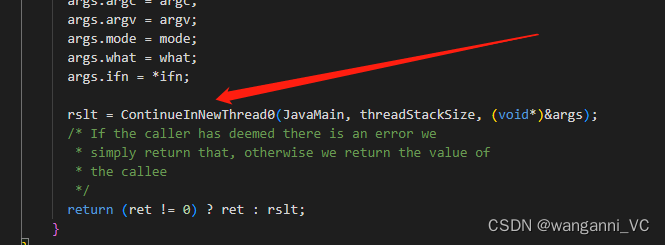
在JavaMain中有一个InitializeJVM,表示初始化JVM。这里面最终调用了create_vm()函数来完成初始化。
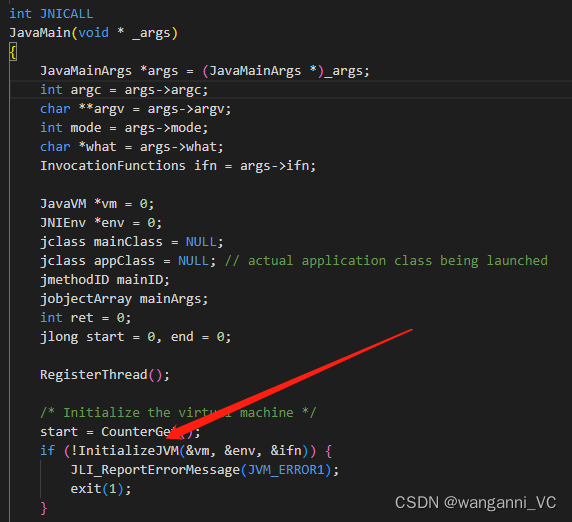
最后创建Java虚拟机进程后,回到JavaMain函数下面有这么一行, 把mainClass赋值为我们写的调用的主函数

用CallStaticVoidMethod调用我们在Java里面写的Java入口函数mainClass。LEAVE()函数表示启动器的退出代码,将会等待所有非守护进程线程结束,然后销毁虚拟机。
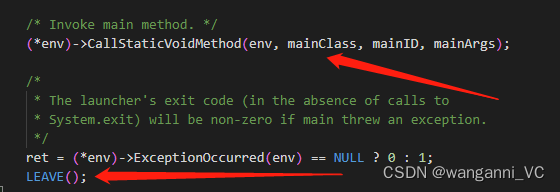
JVM初始化调用路径
JNI_CreateJavaVM()函数调用Threads模块create_vm()函数完成虚拟机的创建和初始胡工作。在create_vm()函数初始化了JVM系统中绝大多数模块。下文选取该过程展开详解
InitializeJVM()--->InvocationFunctions()
--->LoadJavaVM()--->JNI_CreateJavaVM()--->Threads::create_vm()
create_vm()函数
hotspot/src/share/vm/runtime/thread.cpp 3358
/*
返回值:jint
参数1:JavaVMInitArgs* //入参
参数2:canTryAgain //该标志设置为1
*/
jint Threads::create_vm(JavaVMInitArgs* args, bool* canTryAgain)
{
extern void JDK_Version_init();
// 仅定义接口,未实现,【11和17版本针对arm系统进行了初始化】
VM_Version::early_initialize();
// 检查版本信息是否为1.2 1.4 1.6 1.8
if (!is_supported_jni_version(args->version)) return JNI_EVERSION;
// 输出流模块初始化,设置了gc流信息从0开始,而不是第一次gc的时间戳
ostream_init();
// 读取args->options信息,将-Dsun.java.launcher和-Dsun.java.launcher.pid参数值储存起来
Arguments::process_sun_java_launcher_properties(args);
// 主要是内存、栈、线程等OS密切的部分的初始化
os::init();
// 设置jvm的参数和系统参数,在java中调用的System.getProperty方法的所有参数值都在自此方法中设置
Arguments::init_system_properties();
// 全部的初始化,包括大版本,小版本,安全,构建以及补丁的版本号,包含全部信息
JDK_Version_init();
// 再次设置的系统信息,java.vm.specification.vendor、java.vm.specification.version、java.vm.vendor
Arguments::init_version_specific_system_properties();
// Parse arguments
// Note: this internally calls os::init_container_support()
jint parse_result = Arguments::parse(args);
if (parse_result != JNI_OK) return parse_result;
/*
关于提高jvm和gc性能的设置
1.设置可用处理器的数量.
2.设置lage page size
3.设置其他特征
*/
os::init_before_ergo();
jint ergo_result = Arguments::apply_ergo();
if (ergo_result != JNI_OK) return ergo_result;
if (PauseAtStartup) {
os::pause();
}
if (DumpSharedSpaces) {
// when dumping shared spaces for AppCDS we must disable bytecode
// rewriting as it initializes internal (cached) meta-data that
// would be stored in the archive but cannot be carried over to
// the next execution
RewriteBytecodes = false;
}
#ifndef USDT2
HS_DTRACE_PROBE(hotspot, vm__init__begin);
#else /* USDT2 */
HOTSPOT_VM_INIT_BEGIN();
#endif /* USDT2 */
// 记录VM创建时间统计信息
TraceVmCreationTime create_vm_timer;
create_vm_timer.start();
// Timing (must come after argument parsing)
TraceTime timer("Create VM", TraceStartupTime);
/*
OS模块的二次初始化,包含线程锁的初始,polling_page和mem_serialize_page分配内存,
信号处理初始化,设置线程栈大小,libpthread初始化,设置线程锁,线程优先级策略的初始化
*/
jint os_init_2_result = os::init_2();
if (os_init_2_result != JNI_OK) return os_init_2_result;
//UseNUMA时额外的参数设置
jint adjust_after_os_result = Arguments::adjust_after_os();
if (adjust_after_os_result != JNI_OK) return adjust_after_os_result;
// 初始化TLS
ThreadLocalStorage::init();
// 初始化GC日志和LoadedClass日志的fileStream对象
ostream_init_log();
// 将参数-Xrun 转换成 -agentlib参数
// Convert -Xrun to -agentlib: if there is no JVM_OnLoad
// Must be before create_vm_init_agents()
if (Arguments::init_libraries_at_startup()) {
convert_vm_init_libraries_to_agents();
}
//根据-agentlib/-agentpath and 转换后 -Xrun参数创建agents
if (Arguments::init_agents_at_startup()) {
create_vm_init_agents();
}
// Initialize Threads state
_thread_list = NULL;
_number_of_threads = 0;
_number_of_non_daemon_threads = 0;
// 初始化Events,各种锁,ChunkPool,PerfMemory
vm_init_globals();
/*
创建一个新的JavaThread并设置相关属性,注意这里并未创建一个新的线程,
而是将当前线程同JavaThread对象关联起来,通过JavaThread管理相关属性
*/
JavaThread* main_thread = new JavaThread();
main_thread->set_thread_state(_thread_in_vm);
// must do this before set_active_handles and initialize_thread_local_storage
// Note: on solaris initialize_thread_local_storage() will (indirectly)
// change the stack size recorded here to one based on the java thread
// stacksize. This adjusted size is what is used to figure the placement
// of the guard pages.
main_thread->record_stack_base_and_size();
main_thread->initialize_thread_local_storage();
main_thread->set_active_handles(JNIHandleBlock::allocate_block());
if (!main_thread->set_as_starting_thread()) {
vm_shutdown_during_initialization(
"Failed necessary internal allocation. Out of swap space");
delete main_thread;
*canTryAgain = false; // don't let caller call JNI_CreateJavaVM again
return JNI_ENOMEM;
}
// Enable guard page *after* os::create_main_thread(), otherwise it would
// crash Linux VM, see notes in os_linux.cpp.
main_thread->create_stack_guard_pages();
// Initialize Java-Level synchronization subsystem
ObjectMonitor::Initialize() ;
/*
全局模块初始化,如Management模块,Bytecodes模块,ClassLoader模块,
CodeCache模块,StubRoutines模块,Universe模块,Interpreter模块等
*/
jint status = init_globals();
if (status != JNI_OK) {
delete main_thread;
*canTryAgain = false; // don't let caller call JNI_CreateJavaVM again
return status;
}
JFR_ONLY(Jfr::on_vm_init();)
// Should be done after the heap is fully created
main_thread->cache_global_variables();
HandleMark hm;
{ MutexLocker mu(Threads_lock);
//将线程加入线程队列
Threads::add(main_thread);
}
// Any JVMTI raw monitors entered in onload will transition into
// real raw monitor. VM is setup enough here for raw monitor enter.
JvmtiExport::transition_pending_onload_raw_monitors();
// Create the VMThread,创建虚拟机线程
{ TraceTime timer("Start VMThread", TraceStartupTime);
VMThread::create();
Thread* vmthread = VMThread::vm_thread();
if (!os::create_thread(vmthread, os::vm_thread))
vm_exit_during_initialization("Cannot create VM thread. Out of system resources.");
//等待VMThread初始化完成
// Wait for the VM thread to become ready, and VMThread::run to initialize
// Monitors can have spurious returns, must always check another state flag
{
MutexLocker ml(Notify_lock);
os::start_thread(vmthread);
while (vmthread->active_handles() == NULL) {
Notify_lock->wait();
}
}
}
assert (Universe::is_fully_initialized(), "not initialized");
if (VerifyDuringStartup) {
// Make sure we're starting with a clean slate.
//验证VMThread的状态
VM_Verify verify_op;
VMThread::execute(&verify_op);
}
EXCEPTION_MARK;
// At this point, the Universe is initialized, but we have not executed
// any byte code. Now is a good time (the only time) to dump out the
// internal state of the JVM for sharing, unless AppCDS is enabled.
if (!UseAppCDS && DumpSharedSpaces) {
//Dump元空间
MetaspaceShared::preload_and_dump(CHECK_0);
ShouldNotReachHere();
}
//标记JVMTI启用
// Always call even when there are not JVMTI environments yet, since environments
// may be attached late and JVMTI must track phases of VM execution
JvmtiExport::enter_start_phase();
//通知JVMTI agents虚机已启动
// Notify JVMTI agents that VM has started (JNI is up) - nop if no agents.
JvmtiExport::post_vm_start();
//加载核心Java类文件
{
TraceTime timer("Initialize java.lang classes", TraceStartupTime);
if (EagerXrunInit && Arguments::init_libraries_at_startup()) {
create_vm_init_libraries();
}
initialize_class(vmSymbols::java_lang_String(), CHECK_0);
// Initialize java_lang.System (needed before creating the thread)
initialize_class(vmSymbols::java_lang_System(), CHECK_0);
initialize_class(vmSymbols::java_lang_ThreadGroup(), CHECK_0);
Handle thread_group = create_initial_thread_group(CHECK_0);
Universe::set_main_thread_group(thread_group());
initialize_class(vmSymbols::java_lang_Thread(), CHECK_0);
oop thread_object = create_initial_thread(thread_group, main_thread, CHECK_0);
main_thread->set_threadObj(thread_object);
// Set thread status to running since main thread has
// been started and running.
java_lang_Thread::set_thread_status(thread_object,
java_lang_Thread::RUNNABLE);
// The VM creates & returns objects of this class. Make sure it's initialized.
initialize_class(vmSymbols::java_lang_Class(), CHECK_0);
// The VM preresolves methods to these classes. Make sure that they get initialized
initialize_class(vmSymbols::java_lang_reflect_Method(), CHECK_0);
initialize_class(vmSymbols::java_lang_ref_Finalizer(), CHECK_0);
call_initializeSystemClass(CHECK_0);
// get the Java runtime name after java.lang.System is initialized
JDK_Version::set_runtime_name(get_java_runtime_name(THREAD));
JDK_Version::set_runtime_version(get_java_runtime_version(THREAD));
// an instance of OutOfMemory exception has been allocated earlier
initialize_class(vmSymbols::java_lang_OutOfMemoryError(), CHECK_0);
initialize_class(vmSymbols::java_lang_NullPointerException(), CHECK_0);
initialize_class(vmSymbols::java_lang_ClassCastException(), CHECK_0);
initialize_class(vmSymbols::java_lang_ArrayStoreException(), CHECK_0);
initialize_class(vmSymbols::java_lang_ArithmeticException(), CHECK_0);
initialize_class(vmSymbols::java_lang_StackOverflowError(), CHECK_0);
initialize_class(vmSymbols::java_lang_IllegalMonitorStateException(), CHECK_0);
initialize_class(vmSymbols::java_lang_IllegalArgumentException(), CHECK_0);
}
// See : bugid 4211085.
// Background : the static initializer of java.lang.Compiler tries to read
// property"java.compiler" and read & write property "java.vm.info".
// When a security manager is installed through the command line
// option "-Djava.security.manager", the above properties are not
// readable and the static initializer for java.lang.Compiler fails
// resulting in a NoClassDefFoundError. This can happen in any
// user code which calls methods in java.lang.Compiler.
// Hack : the hack is to pre-load and initialize this class, so that only
// system domains are on the stack when the properties are read.
// Currently even the AWT code has calls to methods in java.lang.Compiler.
// On the classic VM, java.lang.Compiler is loaded very early to load the JIT.
// Future Fix : the best fix is to grant everyone permissions to read "java.compiler" and
// read and write"java.vm.info" in the default policy file. See bugid 4211383
// Once that is done, we should remove this hack.
initialize_class(vmSymbols::java_lang_Compiler(), CHECK_0);
// More hackery - the static initializer of java.lang.Compiler adds the string "nojit" to
// the java.vm.info property if no jit gets loaded through java.lang.Compiler (the hotspot
// compiler does not get loaded through java.lang.Compiler). "java -version" with the
// hotspot vm says "nojit" all the time which is confusing. So, we reset it here.
// This should also be taken out as soon as 4211383 gets fixed.
//将java.vm.info设置成nojit
reset_vm_info_property(CHECK_0);
//初始化JNIEnv中GetField相关接口
quicken_jni_functions();
// Set flag that basic initialization has completed. Used by exceptions and various
// debug stuff, that does not work until all basic classes have been initialized.
// 设置初始化完成标识
set_init_completed();
//元空间的预初始化
Metaspace::post_initialize();
#ifndef USDT2
HS_DTRACE_PROBE(hotspot, vm__init__end);
#else /* USDT2 */
HOTSPOT_VM_INIT_END();
#endif /* USDT2 */
// record VM initialization completion time
#if INCLUDE_MANAGEMENT
// 记录初始化完成时间
Management::record_vm_init_completed();
#endif // INCLUDE_MANAGEMENT
// Compute system loader. Note that this has to occur after set_init_completed, since
// valid exceptions may be thrown in the process.
// Note that we do not use CHECK_0 here since we are inside an EXCEPTION_MARK and
// set_init_completed has just been called, causing exceptions not to be shortcut
// anymore. We call vm_exit_during_initialization directly instead.
SystemDictionary::compute_java_system_loader(THREAD);
if (HAS_PENDING_EXCEPTION) {
vm_exit_during_initialization(Handle(THREAD, PENDING_EXCEPTION));
}
if (UseAppCDS && DumpSharedSpaces) {
MetaspaceShared::preload_and_dump(CHECK_0);
ShouldNotReachHere();
}
#if INCLUDE_ALL_GCS
// Support for ConcurrentMarkSweep. This should be cleaned up
// and better encapsulated. The ugly nested if test would go away
// once things are properly refactored. XXX YSR
//并发标记的初始化,会创建一个新的执行标记的线程
if (UseConcMarkSweepGC || UseG1GC) {
if (UseConcMarkSweepGC) {
ConcurrentMarkSweepThread::makeSurrogateLockerThread(THREAD);
} else {
ConcurrentMarkThread::makeSurrogateLockerThread(THREAD);
G1CollectedHeap::heap()->init_periodic_gc_thread();
}
if (HAS_PENDING_EXCEPTION) {
vm_exit_during_initialization(Handle(THREAD, PENDING_EXCEPTION));
}
}
#endif // INCLUDE_ALL_GCS
// Always call even when there are not JVMTI environments yet, since environments
// may be attached late and JVMTI must track phases of VM execution
//JVMTI打标,标识JVM进入可用状态
JvmtiExport::enter_live_phase();
// Signal Dispatcher needs to be started before VMInit event is posted
//创建一个新的线程处理信号
os::signal_init();
// Start Attach Listener if +StartAttachListener or it can't be started lazily
if (!DisableAttachMechanism) {
//移除.java_pid文件,准备好初始化
AttachListener::vm_start();
if (StartAttachListener || AttachListener::init_at_startup()) {
AttachListener::init();
}
}
// Launch -Xrun agents
// Must be done in the JVMTI live phase so that for backward compatibility the JDWP
// back-end can launch with -Xdebug -Xrunjdwp.
//加载-Xrun执行的agent 库
if (!EagerXrunInit && Arguments::init_libraries_at_startup()) {
create_vm_init_libraries();
}
//通知JVMTI JVM初始化完成
// Notify JVMTI agents that VM initialization is complete - nop if no agents.
JvmtiExport::post_vm_initialized();
JFR_ONLY(Jfr::on_vm_start();)
//开启一个新的线程用于清理ChunkPool
if (CleanChunkPoolAsync) {
Chunk::start_chunk_pool_cleaner_task();
}
// c1 和 c2编译器初始化,会创建编译线程
#if defined(COMPILER1) || defined(COMPILER2) || defined(SHARK)
CompileBroker::compilation_init();
#endif
//加载动态代理相关类
if (EnableInvokeDynamic) {
// Pre-initialize some JSR292 core classes to avoid deadlock during class loading.
// It is done after compilers are initialized, because otherwise compilations of
// signature polymorphic MH intrinsics can be missed
// (see SystemDictionary::find_method_handle_intrinsic).
initialize_class(vmSymbols::java_lang_invoke_MethodHandle(), CHECK_0);
initialize_class(vmSymbols::java_lang_invoke_MemberName(), CHECK_0);
initialize_class(vmSymbols::java_lang_invoke_MethodHandleNatives(), CHECK_0);
}
#if INCLUDE_MANAGEMENT
//加载Management相关类
Management::initialize(THREAD);
#endif // INCLUDE_MANAGEMENT
//management加载失败,退出
if (HAS_PENDING_EXCEPTION) {
// management agent fails to start possibly due to
// configuration problem and is responsible for printing
// stack trace if appropriate. Simply exit VM.
vm_exit(1);
}
//初始化监控任务线程
if (Arguments::has_profile()) FlatProfiler::engage(main_thread, true);
if (MemProfiling) MemProfiler::engage();
StatSampler::engage();
if (CheckJNICalls) JniPeriodicChecker::engage();
//偏向锁的初始化
BiasedLocking::init();
#if INCLUDE_RTM_OPT
RTMLockingCounters::init();
#endif
//回调函数,通知其JVM初始化完成
if (JDK_Version::current().post_vm_init_hook_enabled()) {
call_postVMInitHook(THREAD);
// The Java side of PostVMInitHook.run must deal with all
// exceptions and provide means of diagnosis.
if (HAS_PENDING_EXCEPTION) {
CLEAR_PENDING_EXCEPTION;
}
}
{
MutexLockerEx ml(PeriodicTask_lock, Mutex::_no_safepoint_check_flag);
// Make sure the watcher thread can be started by WatcherThread::start()
// or by dynamic enrollment.
WatcherThread::make_startable();
// Start up the WatcherThread if there are any periodic tasks
// NOTE: All PeriodicTasks should be registered by now. If they
// aren't, late joiners might appear to start slowly (we might
// take a while to process their first tick).
if (PeriodicTask::num_tasks() > 0) {
WatcherThread::start();
}
}
//标记JVM启动完成
create_vm_timer.end();
#ifdef ASSERT
_vm_complete = true;
#endif
return JNI_OK;
}
os:init()函数
// this is called _before_ the most of global arguments have been parsed
void os::init(void) {
char dummy; /* used to get a guess on initial stack address */
// first_hrtime = gethrtime();
// With BsdThreads the JavaMain thread pid (primordial thread)
// is different than the pid of the java launcher thread.
// So, on Bsd, the launcher thread pid is passed to the VM
// via the sun.java.launcher.pid property.
// Use this property instead of getpid() if it was correctly passed.
// See bug 6351349.
pid_t java_launcher_pid = (pid_t) Arguments::sun_java_launcher_pid();
_initial_pid = (java_launcher_pid > 0) ? java_launcher_pid : getpid();
clock_tics_per_sec = CLK_TCK;
init_random(1234567);
ThreadCritical::initialize();
设置系统页大小
Bsd::set_page_size(getpagesize());
if (Bsd::page_size() == -1) {
fatal(err_msg("os_bsd.cpp: os::init: sysconf failed (%s)",
strerror(errno)));
}
init_page_sizes((size_t) Bsd::page_size());
//设置处理器数量、获得物理内存大小
Bsd::initialize_system_info();
//保存当前线程ID
// _main_thread points to the thread that created/loaded the JVM.
Bsd::_main_thread = pthread_self();
//设置系统时钟
Bsd::clock_init();
initial_time_count = javaTimeNanos();
#ifdef __APPLE__
// XXXDARWIN
// Work around the unaligned VM callbacks in hotspot's
// sharedRuntime. The callbacks don't use SSE2 instructions, and work on
// Linux, Solaris, and FreeBSD. On Mac OS X, dyld (rightly so) enforces
// alignment when doing symbol lookup. To work around this, we force early
// binding of all symbols now, thus binding when alignment is known-good.
_dyld_bind_fully_image_containing_address((const void *) &os::init);
#endif
}
os::init_2()函数
// this is called _after_ the global arguments have been parsed
jint os::init_2(void)
{
/*
通过系统调用mmap分配一个可读的单页内存,用于安全点的轮循。
这里介绍一下这个内存页的用处`polling_page`与JVM的垃圾回收机制相关,用于在线程间进行通信,
因为JVM中用户工作线程和GC线程。
具体来说,就是线程通过在`polling_page`上进行轮询,等待特殊的信号或标记,
以知道何时有工作需要执行。这种轮询目的就是为了允许垃圾回收器在并发阶段与用户工作线程
并发执行,以减小垃圾收集带来的暂停时间。
*/
// Allocate a single page and mark it as readable for safepoint polling
address polling_page = (address) ::mmap(NULL, Bsd::page_size(), PROT_READ, MAP_PRIVATE|MAP_ANONYMOUS, -1, 0);
guarantee( polling_page != MAP_FAILED, "os::init_2: failed to allocate polling page" );
// 设置`polling_page`
os::set_polling_page( polling_page );
#ifndef PRODUCT
if(Verbose && PrintMiscellaneous)
tty->print("[SafePoint Polling address: " INTPTR_FORMAT "]\n", (intptr_t)polling_page);
#endif
/*
* UseMembar 为 true 表示使用内存屏障(memory barrier),内存屏障是一种硬件或编译器指令,用于确保内存操作
* 按照代码书写的顺序执行的机制。
* 在多线程编程中,由于线程之间的执行顺序是不确定的,可能导致一些意外的情况,比如数据竞争、缓存一致性问题等。
* Hotspot membar 提供了一种方式来显示地指示内存屏障,以确保在内存中进行的读写操作的顺序性和可见性。
* 具体来讲,Hotspot membar内存屏障可用于:
* 1.防止指令重排序:内存屏障可防止对指令进行优化和重排序,确保代码的执行顺序与编写顺序一致
* 2.保证内存可见性:内存屏障可确保一个线程写入的数据对其他线程是可见的,避免由于线程间缓存不一致性导致的问题
* 3.实现同步机制:在多线程环境中,使用内存屏障可以实现一些同步机制,比如在临界区前后插入内存屏障,以确保线程
* 按照期望的顺序执行。
*/
if (!UseMembar) {
// 这里的意思是虚拟机没有开放内存屏障,就用系统调用mmap分配一个页大小的内存操作来代替,现在知道有这个东西就行,后面在讲解安全点知识时会细讲这个的作用
address mem_serialize_page = (address) ::mmap(NULL, Bsd::page_size(), PROT_READ | PROT_WRITE, MAP_PRIVATE|MAP_ANONYMOUS, -1, 0);
guarantee( mem_serialize_page != MAP_FAILED, "mmap Failed for memory serialize page");
os::set_memory_serialize_page( mem_serialize_page );
#ifndef PRODUCT
if(Verbose && PrintMiscellaneous)
tty->print("[Memory Serialize Page address: " INTPTR_FORMAT "]\n", (intptr_t)mem_serialize_page);
#endif
}
//初始化内核信号
// initialize suspend/resume support - must do this before signal_sets_init()
if (SR_initialize() != 0) {
perror("SR_initialize failed");
return JNI_ERR;
}
//继续系统级别的信号初始化,比如SIGSEGV、SIGBUS等
Bsd::signal_sets_init();
// 给对应的信号安装/设置处理器程序
Bsd::install_signal_handlers();
// Check minimum allowable stack size for thread creation and to initialize
// the java system classes, including StackOverflowError - depends on page
// size. Add a page for compiler2 recursion in main thread.
// Add in 2*BytesPerWord times page size to account for VM stack during
// class initialization depending on 32 or 64 bit VM.
// 校验最小的线程栈大小,默认最小就是64k
os::Bsd::min_stack_allowed = MAX2(os::Bsd::min_stack_allowed,
(size_t)(StackYellowPages+StackRedPages+StackShadowPages+
2*BytesPerWord COMPILER2_PRESENT(+1)) * Bsd::page_size());
// 拿到默认设置/用户设置的ThreadStackSize
size_t threadStackSizeInBytes = ThreadStackSize * K;
// 比较,如果ThreadStackSize太小,就报错,退出
if (threadStackSizeInBytes != 0 &&
threadStackSizeInBytes < os::Bsd::min_stack_allowed) {
tty->print_cr("\nThe stack size specified is too small, "
"Specify at least %dk",
os::Bsd::min_stack_allowed/ K);
return JNI_ERR;
}
// Make the stack size a multiple of the page size so that
// the yellow/red zones can be guarded.
JavaThread::set_stack_size_at_create(round_to(threadStackSizeInBytes,
vm_page_size()));
// 设置最大文件描述符限制
if (MaxFDLimit) {
// set the number of file descriptors to max. print out error
// if getrlimit/setrlimit fails but continue regardless.
struct rlimit nbr_files;
int status = getrlimit(RLIMIT_NOFILE, &nbr_files);
if (status != 0) {
if (PrintMiscellaneous && (Verbose || WizardMode))
perror("os::init_2 getrlimit failed");
} else {
nbr_files.rlim_cur = nbr_files.rlim_max;
#ifdef __APPLE__
// Darwin returns RLIM_INFINITY for rlim_max, but fails with EINVAL if
// you attempt to use RLIM_INFINITY. As per setrlimit(2), OPEN_MAX must
// be used instead
nbr_files.rlim_cur = MIN(OPEN_MAX, nbr_files.rlim_cur);
#endif
status = setrlimit(RLIMIT_NOFILE, &nbr_files);
if (status != 0) {
if (PrintMiscellaneous && (Verbose || WizardMode))
perror("os::init_2 setrlimit failed");
}
}
}
// at-exit methods are called in the reverse order of their registration.
// atexit functions are called on return from main or as a result of a
// call to exit(3C). There can be only 32 of these functions registered
// and atexit() does not set errno.
if (PerfAllowAtExitRegistration) {
// only register atexit functions if PerfAllowAtExitRegistration is set.
// atexit functions can be delayed until process exit time, which
// can be problematic for embedded VM situations. Embedded VMs should
// call DestroyJavaVM() to assure that VM resources are released.
// note: perfMemory_exit_helper atexit function may be removed in
// the future if the appropriate cleanup code can be added to the
// VM_Exit VMOperation's doit method.
if (atexit(perfMemory_exit_helper) != 0) {
warning("os::init2 atexit(perfMemory_exit_helper) failed");
}
}
// // 初始化线程优先级策略,主要分为-1(线程初始化状态时,没有等级)、1、5、9、10/11 5个等级
prio_init();
#ifdef __APPLE__
// dynamically link to objective c gc registration
void *handleLibObjc = dlopen(OBJC_LIB, RTLD_LAZY);
if (handleLibObjc != NULL) {
objc_registerThreadWithCollectorFunction = (objc_registerThreadWithCollector_t) dlsym(handleLibObjc, OBJC_GCREGISTER);
}
#endif
return JNI_OK;
}
SR_initialize()函数
static int SR_initialize() {
struct sigaction act;
char *s;
//通过环境变量_JAVA_SR_SIGNUM获取初始信号值
/* Get signal number to use for suspend/resume */
if ((s = ::getenv("_JAVA_SR_SIGNUM")) != 0) {
int sig = ::strtol(s, 0, 10);
if (sig > 0 || sig < NSIG) {
SR_signum = sig;
}
}
assert(SR_signum > SIGSEGV && SR_signum > SIGBUS,
"SR_signum must be greater than max(SIGSEGV, SIGBUS), see 4355769");
//清空信号集
sigemptyset(&SR_sigset);
//添加信号至信号集
sigaddset(&SR_sigset, SR_signum);
/* 设置挂起/恢复的信号处理程序 */
act.sa_flags = SA_RESTART|SA_SIGINFO;
act.sa_handler = (void (*)(int)) SR_handler;
// SR_signum is blocked by default.
// 4528190 - We also need to block pthread restart signal (32 on all
// supported Bsd platforms). Note that BsdThreads need to block
// this signal for all threads to work properly. So we don't have
// to use hard-coded signal number when setting up the mask.
//获取当前线程信号屏蔽码
pthread_sigmask(SIG_BLOCK, NULL, &act.sa_mask);
//给信号指定相关的处理程序
if (sigaction(SR_signum, &act, 0) == -1) {
return -1;
}
// Save signal flag 保存信号标志
os::Bsd::set_our_sigflags(SR_signum, act.sa_flags);
return 0;
}
 JVM启动流程与初始化调用路径解析
JVM启动流程与初始化调用路径解析





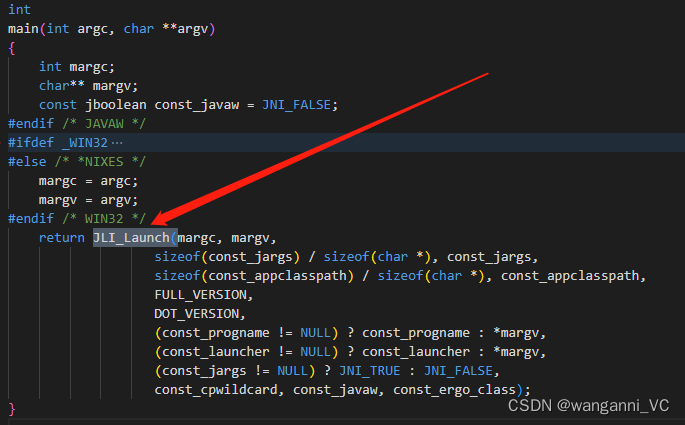
















 554
554

 被折叠的 条评论
为什么被折叠?
被折叠的 条评论
为什么被折叠?








